重塑和透视表#
通过旋转DataFrame对象进行整形#
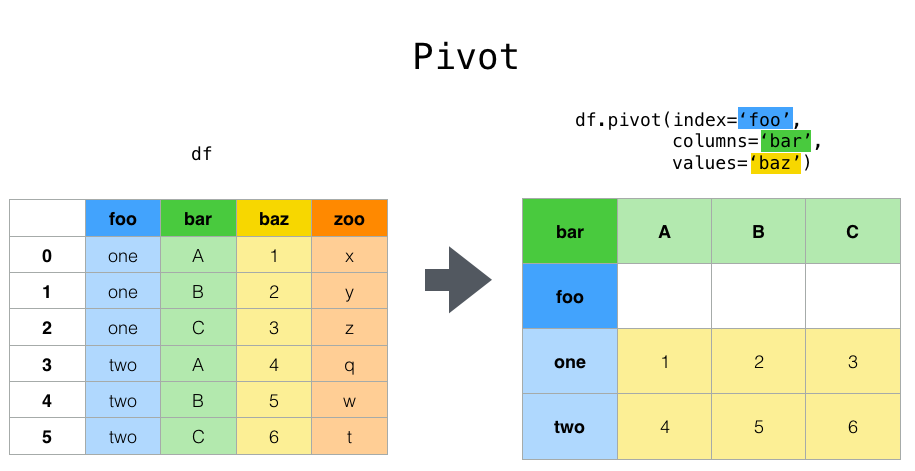
数据通常以所谓的“堆叠”或“记录”格式存储:
In [1]: import pandas._testing as tm
In [2]: def unpivot(frame):
...: N, K = frame.shape
...: data = {
...: "value": frame.to_numpy().ravel("F"),
...: "variable": np.asarray(frame.columns).repeat(N),
...: "date": np.tile(np.asarray(frame.index), K),
...: }
...: return pd.DataFrame(data, columns=["date", "variable", "value"])
...:
In [3]: df = unpivot(tm.makeTimeDataFrame(3))
In [4]: df
Out[4]:
date variable value
0 2000-01-03 A 0.469112
1 2000-01-04 A -0.282863
2 2000-01-05 A -1.509059
3 2000-01-03 B -1.135632
4 2000-01-04 B 1.212112
5 2000-01-05 B -0.173215
6 2000-01-03 C 0.119209
7 2000-01-04 C -1.044236
8 2000-01-05 C -0.861849
9 2000-01-03 D -2.104569
10 2000-01-04 D -0.494929
11 2000-01-05 D 1.071804
为变量选择所有内容 A 我们可以这样做:
In [5]: filtered = df[df["variable"] == "A"]
In [6]: filtered
Out[6]:
date variable value
0 2000-01-03 A 0.469112
1 2000-01-04 A -0.282863
2 2000-01-05 A -1.509059
但假设我们希望对变量进行时间序列运算。更好的表现应该是 columns 是唯一的变量和 index 日期确定个人的观察结果。要将数据重塑为此表单,我们使用 DataFrame.pivot() 方法(也实现为顶级函数 pivot() ):
In [7]: pivoted = df.pivot(index="date", columns="variable", values="value")
In [8]: pivoted
Out[8]:
variable A B C D
date
2000-01-03 0.469112 -1.135632 0.119209 -2.104569
2000-01-04 -0.282863 1.212112 -1.044236 -0.494929
2000-01-05 -1.509059 -0.173215 -0.861849 1.071804
如果 values 参数被省略,并且输入 DataFrame 具有不用作列或索引输入的多列值 pivot() ,那么由此产生的“旋转” DataFrame 将会有 hierarchical columns 其最高级别表示各自的值列:
In [9]: df["value2"] = df["value"] * 2
In [10]: pivoted = df.pivot(index="date", columns="variable")
In [11]: pivoted
Out[11]:
value value2
variable A B C D A B C D
date
2000-01-03 0.469112 -1.135632 0.119209 -2.104569 0.938225 -2.271265 0.238417 -4.209138
2000-01-04 -0.282863 1.212112 -1.044236 -0.494929 -0.565727 2.424224 -2.088472 -0.989859
2000-01-05 -1.509059 -0.173215 -0.861849 1.071804 -3.018117 -0.346429 -1.723698 2.143608
然后,您可以从旋转的 DataFrame :
In [12]: pivoted["value2"]
Out[12]:
variable A B C D
date
2000-01-03 0.938225 -2.271265 0.238417 -4.209138
2000-01-04 -0.565727 2.424224 -2.088472 -0.989859
2000-01-05 -3.018117 -0.346429 -1.723698 2.143608
请注意,在数据是同构类型的情况下,这将返回底层数据的视图。
备注
pivot() 将使用 ValueError: Index contains duplicate entries, cannot reshape 如果索引/列对不是唯一的。在这种情况下,可以考虑使用 pivot_table() 它是PIVOT的泛化,可以处理一个索引/列对的重复值。
通过堆叠和取消堆叠来重塑#
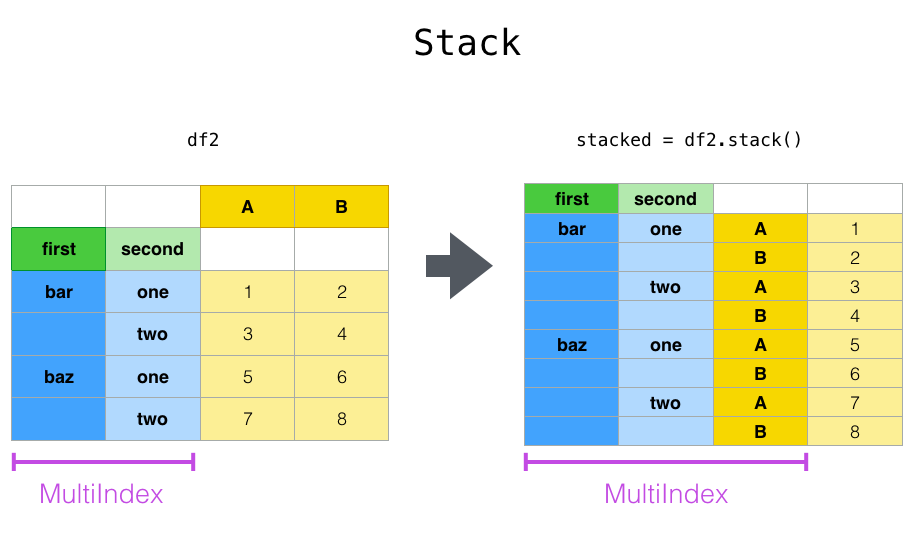
与此密切相关 pivot() 方法是相关的 stack() 和 unstack() 上提供的方法 Series 和 DataFrame 。这些方法旨在与 MultiIndex 对象(请参阅 hierarchical indexing )。以下是这些方法的基本功能:
stack():“Pivot”列标签的一个级别(可能是分层的),返回一个DataFrame具有具有新的最内层行标签的索引。unstack():(逆运算stack())将行索引的一级(可能是分层的)“透视”到列轴,从而产生重塑的DataFrame具有新的最内层的列标签。
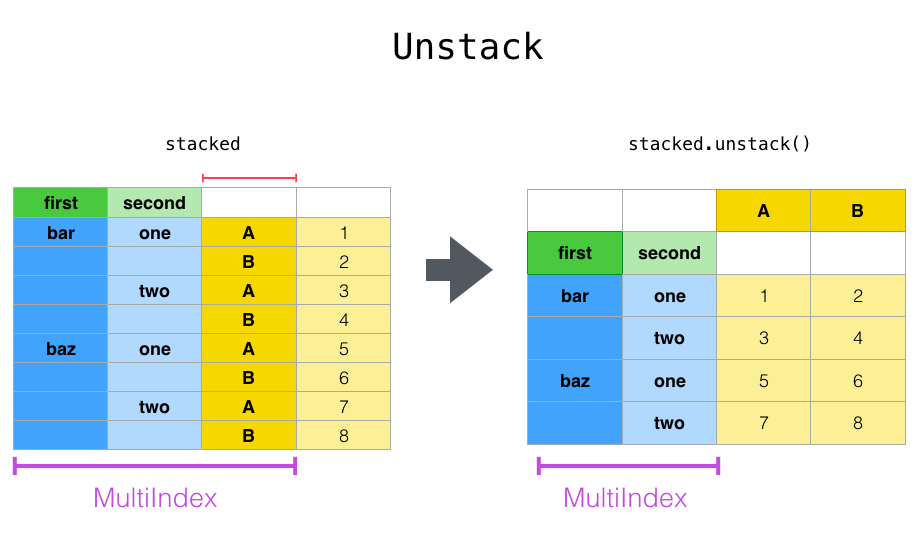
最清晰的解释方式就是举一反三。让我们以前面的层次索引部分中的一个示例数据集为例:
In [13]: tuples = list(
....: zip(
....: *[
....: ["bar", "bar", "baz", "baz", "foo", "foo", "qux", "qux"],
....: ["one", "two", "one", "two", "one", "two", "one", "two"],
....: ]
....: )
....: )
....:
In [14]: index = pd.MultiIndex.from_tuples(tuples, names=["first", "second"])
In [15]: df = pd.DataFrame(np.random.randn(8, 2), index=index, columns=["A", "B"])
In [16]: df2 = df[:4]
In [17]: df2
Out[17]:
A B
first second
bar one 0.721555 -0.706771
two -1.039575 0.271860
baz one -0.424972 0.567020
two 0.276232 -1.087401
这个 stack() 函数将“压缩” DataFrame 用于产生以下任一结果的列:
A
Series,在简单列索引的情况下。A
DataFrame的情况下,MultiIndex在栏目里。
如果这些列具有 MultiIndex ,您可以选择要堆叠的级别。堆叠的级别将成为 MultiIndex 在各栏上:
In [18]: stacked = df2.stack()
In [19]: stacked
Out[19]:
first second
bar one A 0.721555
B -0.706771
two A -1.039575
B 0.271860
baz one A -0.424972
B 0.567020
two A 0.276232
B -1.087401
dtype: float64
用一个“堆叠的” DataFrame 或 Series (有一个 MultiIndex 作为 index )的逆运算。 stack() 是 unstack() ,这在默认情况下会将 最后一关 :
In [20]: stacked.unstack()
Out[20]:
A B
first second
bar one 0.721555 -0.706771
two -1.039575 0.271860
baz one -0.424972 0.567020
two 0.276232 -1.087401
In [21]: stacked.unstack(1)
Out[21]:
second one two
first
bar A 0.721555 -1.039575
B -0.706771 0.271860
baz A -0.424972 0.276232
B 0.567020 -1.087401
In [22]: stacked.unstack(0)
Out[22]:
first bar baz
second
one A 0.721555 -0.424972
B -0.706771 0.567020
two A -1.039575 0.276232
B 0.271860 -1.087401
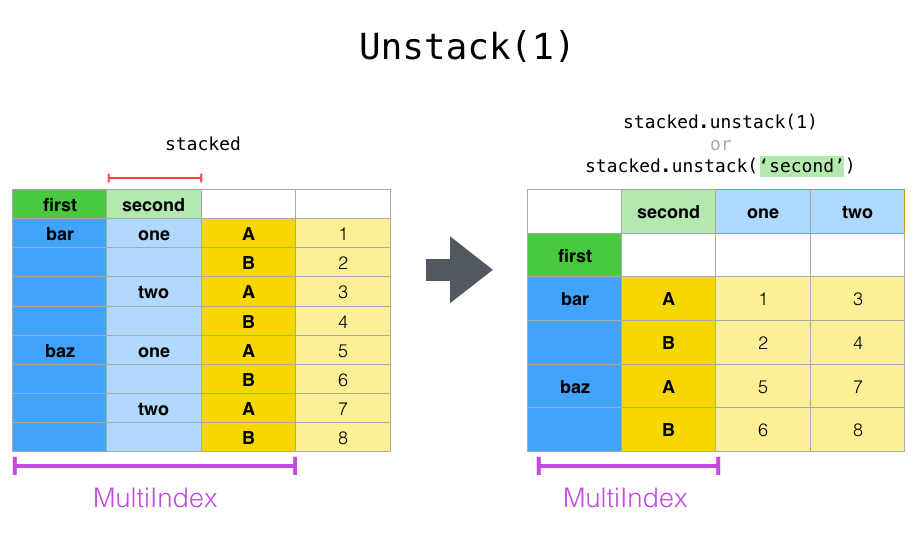
如果索引有名称,则可以使用级别名称,而不是指定级别编号:
In [23]: stacked.unstack("second")
Out[23]:
second one two
first
bar A 0.721555 -1.039575
B -0.706771 0.271860
baz A -0.424972 0.276232
B 0.567020 -1.087401
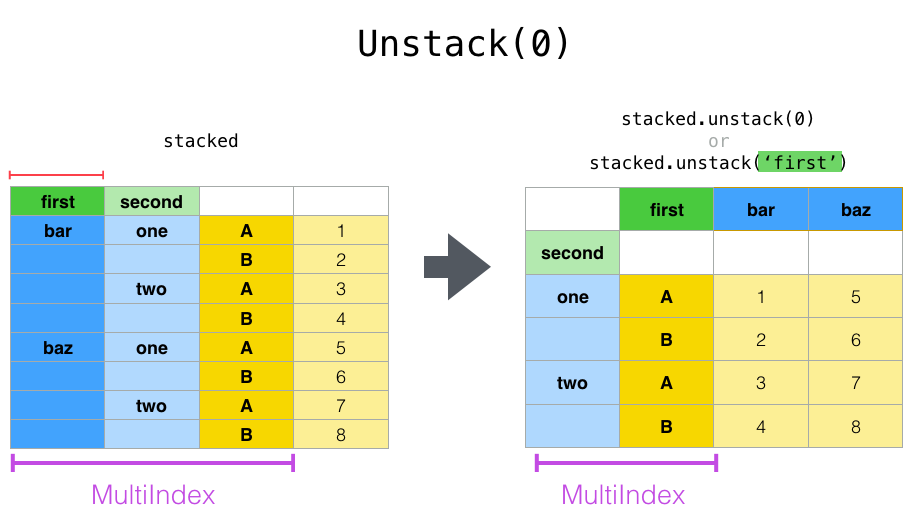
请注意, stack() 和 unstack() 方法隐式地对所涉及的索引级别进行排序。因此,呼吁 stack() 然后 unstack() ,或反之亦然,将导致 排序 原件复印件 DataFrame 或 Series :
In [24]: index = pd.MultiIndex.from_product([[2, 1], ["a", "b"]])
In [25]: df = pd.DataFrame(np.random.randn(4), index=index, columns=["A"])
In [26]: df
Out[26]:
A
2 a -0.370647
b -1.157892
1 a -1.344312
b 0.844885
In [27]: all(df.unstack().stack() == df.sort_index())
Out[27]: True
上面的代码将引发一个 TypeError 如果调用 sort_index() 被移除。
多层次#
您还可以通过传递级别列表来一次堆叠或拆分多个级别,在这种情况下,最终结果就好像列表中的每个级别都是单独处理的一样。
In [28]: columns = pd.MultiIndex.from_tuples(
....: [
....: ("A", "cat", "long"),
....: ("B", "cat", "long"),
....: ("A", "dog", "short"),
....: ("B", "dog", "short"),
....: ],
....: names=["exp", "animal", "hair_length"],
....: )
....:
In [29]: df = pd.DataFrame(np.random.randn(4, 4), columns=columns)
In [30]: df
Out[30]:
exp A B A B
animal cat cat dog dog
hair_length long long short short
0 1.075770 -0.109050 1.643563 -1.469388
1 0.357021 -0.674600 -1.776904 -0.968914
2 -1.294524 0.413738 0.276662 -0.472035
3 -0.013960 -0.362543 -0.006154 -0.923061
In [31]: df.stack(level=["animal", "hair_length"])
Out[31]:
exp A B
animal hair_length
0 cat long 1.075770 -0.109050
dog short 1.643563 -1.469388
1 cat long 0.357021 -0.674600
dog short -1.776904 -0.968914
2 cat long -1.294524 0.413738
dog short 0.276662 -0.472035
3 cat long -0.013960 -0.362543
dog short -0.006154 -0.923061
标高列表可以包含标高名称或标高编号(但不能同时包含两者)。
# df.stack(level=['animal', 'hair_length'])
# from above is equivalent to:
In [32]: df.stack(level=[1, 2])
Out[32]:
exp A B
animal hair_length
0 cat long 1.075770 -0.109050
dog short 1.643563 -1.469388
1 cat long 0.357021 -0.674600
dog short -1.776904 -0.968914
2 cat long -1.294524 0.413738
dog short 0.276662 -0.472035
3 cat long -0.013960 -0.362543
dog short -0.006154 -0.923061
缺少数据#
这些函数对于处理丢失的数据是智能的,并且不期望分层索引中的每个子组具有相同的标签集。它们还可以处理未排序的索引(但您可以通过调用 sort_index() 当然)。下面是一个更复杂的例子:
In [33]: columns = pd.MultiIndex.from_tuples(
....: [
....: ("A", "cat"),
....: ("B", "dog"),
....: ("B", "cat"),
....: ("A", "dog"),
....: ],
....: names=["exp", "animal"],
....: )
....:
In [34]: index = pd.MultiIndex.from_product(
....: [("bar", "baz", "foo", "qux"), ("one", "two")], names=["first", "second"]
....: )
....:
In [35]: df = pd.DataFrame(np.random.randn(8, 4), index=index, columns=columns)
In [36]: df2 = df.iloc[[0, 1, 2, 4, 5, 7]]
In [37]: df2
Out[37]:
exp A B A
animal cat dog cat dog
first second
bar one 0.895717 0.805244 -1.206412 2.565646
two 1.431256 1.340309 -1.170299 -0.226169
baz one 0.410835 0.813850 0.132003 -0.827317
foo one -1.413681 1.607920 1.024180 0.569605
two 0.875906 -2.211372 0.974466 -2.006747
qux two -1.226825 0.769804 -1.281247 -0.727707
如上所述, stack() 可以使用 level 参数选择要堆叠的列中的哪个级别:
In [38]: df2.stack("exp")
Out[38]:
animal cat dog
first second exp
bar one A 0.895717 2.565646
B -1.206412 0.805244
two A 1.431256 -0.226169
B -1.170299 1.340309
baz one A 0.410835 -0.827317
B 0.132003 0.813850
foo one A -1.413681 0.569605
B 1.024180 1.607920
two A 0.875906 -2.006747
B 0.974466 -2.211372
qux two A -1.226825 -0.727707
B -1.281247 0.769804
In [39]: df2.stack("animal")
Out[39]:
exp A B
first second animal
bar one cat 0.895717 -1.206412
dog 2.565646 0.805244
two cat 1.431256 -1.170299
dog -0.226169 1.340309
baz one cat 0.410835 0.132003
dog -0.827317 0.813850
foo one cat -1.413681 1.024180
dog 0.569605 1.607920
two cat 0.875906 0.974466
dog -2.006747 -2.211372
qux two cat -1.226825 -1.281247
dog -0.727707 0.769804
如果子组不具有相同的标签集,则取消堆叠可能会导致缺少值。默认情况下,缺少的值将被该数据类型的默认填充值替换, NaN 对于浮动, NaT 对于类似日期的类型,等等。对于整型类型,默认情况下,数据将转换为浮点型,缺少的值将设置为 NaN 。
In [40]: df3 = df.iloc[[0, 1, 4, 7], [1, 2]]
In [41]: df3
Out[41]:
exp B
animal dog cat
first second
bar one 0.805244 -1.206412
two 1.340309 -1.170299
foo one 1.607920 1.024180
qux two 0.769804 -1.281247
In [42]: df3.unstack()
Out[42]:
exp B
animal dog cat
second one two one two
first
bar 0.805244 1.340309 -1.206412 -1.170299
foo 1.607920 NaN 1.024180 NaN
qux NaN 0.769804 NaN -1.281247
或者,取消堆栈需要一个可选的 fill_value 参数,用于指定缺失数据的值。
In [43]: df3.unstack(fill_value=-1e9)
Out[43]:
exp B
animal dog cat
second one two one two
first
bar 8.052440e-01 1.340309e+00 -1.206412e+00 -1.170299e+00
foo 1.607920e+00 -1.000000e+09 1.024180e+00 -1.000000e+09
qux -1.000000e+09 7.698036e-01 -1.000000e+09 -1.281247e+00
使用多索引#
当柱是 MultiIndex 在做正确的事情时也很谨慎:
In [44]: df[:3].unstack(0)
Out[44]:
exp A B A
animal cat dog cat dog
first bar baz bar baz bar baz bar baz
second
one 0.895717 0.410835 0.805244 0.81385 -1.206412 0.132003 2.565646 -0.827317
two 1.431256 NaN 1.340309 NaN -1.170299 NaN -0.226169 NaN
In [45]: df2.unstack(1)
Out[45]:
exp A B A
animal cat dog cat dog
second one two one two one two one two
first
bar 0.895717 1.431256 0.805244 1.340309 -1.206412 -1.170299 2.565646 -0.226169
baz 0.410835 NaN 0.813850 NaN 0.132003 NaN -0.827317 NaN
foo -1.413681 0.875906 1.607920 -2.211372 1.024180 0.974466 0.569605 -2.006747
qux NaN -1.226825 NaN 0.769804 NaN -1.281247 NaN -0.727707
熔化重塑#
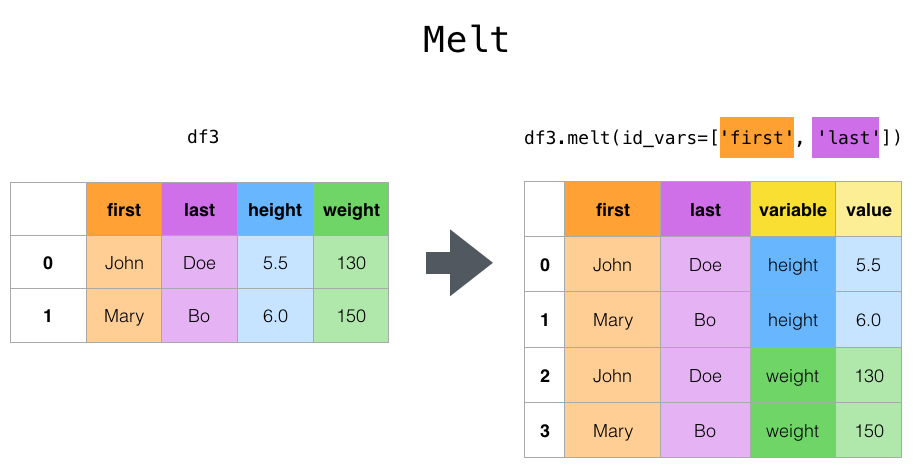
最高层 melt() 函数和相应的 DataFrame.melt() 对按摩一个人很有用 DataFrame 转换为一列或多列的格式 标识符变量 ,而所有其他列,则考虑 测量变量 “不旋转”到行轴,只剩下两个非标识符列“Variable”和“Value”。这些列的名称可以通过提供 var_name 和 value_name 参数。
例如,
In [46]: cheese = pd.DataFrame(
....: {
....: "first": ["John", "Mary"],
....: "last": ["Doe", "Bo"],
....: "height": [5.5, 6.0],
....: "weight": [130, 150],
....: }
....: )
....:
In [47]: cheese
Out[47]:
first last height weight
0 John Doe 5.5 130
1 Mary Bo 6.0 150
In [48]: cheese.melt(id_vars=["first", "last"])
Out[48]:
first last variable value
0 John Doe height 5.5
1 Mary Bo height 6.0
2 John Doe weight 130.0
3 Mary Bo weight 150.0
In [49]: cheese.melt(id_vars=["first", "last"], var_name="quantity")
Out[49]:
first last quantity value
0 John Doe height 5.5
1 Mary Bo height 6.0
2 John Doe weight 130.0
3 Mary Bo weight 150.0
使用转换DataFrame时 melt() ,则该索引将被忽略。属性可以保留原始索引值。 ignore_index 参数设置为 False (默认为 True )。然而,这将复制它们。
1.1.0 新版功能.
In [50]: index = pd.MultiIndex.from_tuples([("person", "A"), ("person", "B")])
In [51]: cheese = pd.DataFrame(
....: {
....: "first": ["John", "Mary"],
....: "last": ["Doe", "Bo"],
....: "height": [5.5, 6.0],
....: "weight": [130, 150],
....: },
....: index=index,
....: )
....:
In [52]: cheese
Out[52]:
first last height weight
person A John Doe 5.5 130
B Mary Bo 6.0 150
In [53]: cheese.melt(id_vars=["first", "last"])
Out[53]:
first last variable value
0 John Doe height 5.5
1 Mary Bo height 6.0
2 John Doe weight 130.0
3 Mary Bo weight 150.0
In [54]: cheese.melt(id_vars=["first", "last"], ignore_index=False)
Out[54]:
first last variable value
person A John Doe height 5.5
B Mary Bo height 6.0
A John Doe weight 130.0
B Mary Bo weight 150.0
另一种转换方法是使用 wide_to_long() 面板数据便捷功能。它的灵活性不如 melt() ,但更人性化。
In [55]: dft = pd.DataFrame(
....: {
....: "A1970": {0: "a", 1: "b", 2: "c"},
....: "A1980": {0: "d", 1: "e", 2: "f"},
....: "B1970": {0: 2.5, 1: 1.2, 2: 0.7},
....: "B1980": {0: 3.2, 1: 1.3, 2: 0.1},
....: "X": dict(zip(range(3), np.random.randn(3))),
....: }
....: )
....:
In [56]: dft["id"] = dft.index
In [57]: dft
Out[57]:
A1970 A1980 B1970 B1980 X id
0 a d 2.5 3.2 -0.121306 0
1 b e 1.2 1.3 -0.097883 1
2 c f 0.7 0.1 0.695775 2
In [58]: pd.wide_to_long(dft, ["A", "B"], i="id", j="year")
Out[58]:
X A B
id year
0 1970 -0.121306 a 2.5
1 1970 -0.097883 b 1.2
2 1970 0.695775 c 0.7
0 1980 -0.121306 d 3.2
1 1980 -0.097883 e 1.3
2 1980 0.695775 f 0.1
与统计数据和分组依据相结合#
结合在一起应该不会令人震惊 pivot() / stack() / unstack() 使用GroupBy以及Basic Series和DataFrame,统计函数可以产生一些非常有表现力的快速数据操作。
In [59]: df
Out[59]:
exp A B A
animal cat dog cat dog
first second
bar one 0.895717 0.805244 -1.206412 2.565646
two 1.431256 1.340309 -1.170299 -0.226169
baz one 0.410835 0.813850 0.132003 -0.827317
two -0.076467 -1.187678 1.130127 -1.436737
foo one -1.413681 1.607920 1.024180 0.569605
two 0.875906 -2.211372 0.974466 -2.006747
qux one -0.410001 -0.078638 0.545952 -1.219217
two -1.226825 0.769804 -1.281247 -0.727707
In [60]: df.stack().mean(1).unstack()
Out[60]:
animal cat dog
first second
bar one -0.155347 1.685445
two 0.130479 0.557070
baz one 0.271419 -0.006733
two 0.526830 -1.312207
foo one -0.194750 1.088763
two 0.925186 -2.109060
qux one 0.067976 -0.648927
two -1.254036 0.021048
# same result, another way
In [61]: df.groupby(level=1, axis=1).mean()
Out[61]:
animal cat dog
first second
bar one -0.155347 1.685445
two 0.130479 0.557070
baz one 0.271419 -0.006733
two 0.526830 -1.312207
foo one -0.194750 1.088763
two 0.925186 -2.109060
qux one 0.067976 -0.648927
two -1.254036 0.021048
In [62]: df.stack().groupby(level=1).mean()
Out[62]:
exp A B
second
one 0.071448 0.455513
two -0.424186 -0.204486
In [63]: df.mean().unstack(0)
Out[63]:
exp A B
animal
cat 0.060843 0.018596
dog -0.413580 0.232430
数据透视表#
而当 pivot() 提供具有各种数据类型(字符串、数字等)的通用透视,PANAS还提供 pivot_table() 用于使用数字数据聚合进行透视。
该函数 pivot_table() 可用于创建电子表格样式的数据透视表。请参阅 cookbook 一些先进的策略。
它需要一些论据:
data:DataFrame对象。values:要聚合的一列或一列。index:与数据长度相同的列、Grouper、数组或它们的列表。透视表索引上分组依据的键。如果传递数组,则它的使用方式与列值相同。columns:与数据长度相同的列、Grouper、数组或它们的列表。透视表表列上分组依据的键。如果传递数组,则它的使用方式与列值相同。aggfunc:用于聚合的函数,默认为numpy.mean。
考虑如下数据集:
In [64]: import datetime
In [65]: df = pd.DataFrame(
....: {
....: "A": ["one", "one", "two", "three"] * 6,
....: "B": ["A", "B", "C"] * 8,
....: "C": ["foo", "foo", "foo", "bar", "bar", "bar"] * 4,
....: "D": np.random.randn(24),
....: "E": np.random.randn(24),
....: "F": [datetime.datetime(2013, i, 1) for i in range(1, 13)]
....: + [datetime.datetime(2013, i, 15) for i in range(1, 13)],
....: }
....: )
....:
In [66]: df
Out[66]:
A B C D E F
0 one A foo 0.341734 -0.317441 2013-01-01
1 one B foo 0.959726 -1.236269 2013-02-01
2 two C foo -1.110336 0.896171 2013-03-01
3 three A bar -0.619976 -0.487602 2013-04-01
4 one B bar 0.149748 -0.082240 2013-05-01
.. ... .. ... ... ... ...
19 three B foo 0.690579 -2.213588 2013-08-15
20 one C foo 0.995761 1.063327 2013-09-15
21 one A bar 2.396780 1.266143 2013-10-15
22 two B bar 0.014871 0.299368 2013-11-15
23 three C bar 3.357427 -0.863838 2013-12-15
[24 rows x 6 columns]
我们可以非常容易地从这些数据生成数据透视表:
In [67]: pd.pivot_table(df, values="D", index=["A", "B"], columns=["C"])
Out[67]:
C bar foo
A B
one A 1.120915 -0.514058
B -0.338421 0.002759
C -0.538846 0.699535
three A -1.181568 NaN
B NaN 0.433512
C 0.588783 NaN
two A NaN 1.000985
B 0.158248 NaN
C NaN 0.176180
In [68]: pd.pivot_table(df, values="D", index=["B"], columns=["A", "C"], aggfunc=np.sum)
Out[68]:
A one three two
C bar foo bar foo bar foo
B
A 2.241830 -1.028115 -2.363137 NaN NaN 2.001971
B -0.676843 0.005518 NaN 0.867024 0.316495 NaN
C -1.077692 1.399070 1.177566 NaN NaN 0.352360
In [69]: pd.pivot_table(
....: df, values=["D", "E"],
....: index=["B"],
....: columns=["A", "C"],
....: aggfunc=np.sum,
....: )
....:
Out[69]:
D E
A one three two one three two
C bar foo bar foo bar foo bar foo bar foo bar foo
B
A 2.241830 -1.028115 -2.363137 NaN NaN 2.001971 2.786113 -0.043211 1.922577 NaN NaN 0.128491
B -0.676843 0.005518 NaN 0.867024 0.316495 NaN 1.368280 -1.103384 NaN -2.128743 -0.194294 NaN
C -1.077692 1.399070 1.177566 NaN NaN 0.352360 -1.976883 1.495717 -0.263660 NaN NaN 0.872482
结果对象是一个 DataFrame 在行和列上具有潜在的分层索引。如果 values 如果未指定列名,则数据透视表将包括可以在列中的其他层次结构级别中聚合的所有数据:
In [70]: pd.pivot_table(df, index=["A", "B"], columns=["C"])
Out[70]:
D E
C bar foo bar foo
A B
one A 1.120915 -0.514058 1.393057 -0.021605
B -0.338421 0.002759 0.684140 -0.551692
C -0.538846 0.699535 -0.988442 0.747859
three A -1.181568 NaN 0.961289 NaN
B NaN 0.433512 NaN -1.064372
C 0.588783 NaN -0.131830 NaN
two A NaN 1.000985 NaN 0.064245
B 0.158248 NaN -0.097147 NaN
C NaN 0.176180 NaN 0.436241
此外,您还可以使用 Grouper 为 index 和 columns 关键字。有关详情,请参阅 Grouper ,请参见 Grouping with a Grouper specification 。
In [71]: pd.pivot_table(df, values="D", index=pd.Grouper(freq="M", key="F"), columns="C")
Out[71]:
C bar foo
F
2013-01-31 NaN -0.514058
2013-02-28 NaN 0.002759
2013-03-31 NaN 0.176180
2013-04-30 -1.181568 NaN
2013-05-31 -0.338421 NaN
2013-06-30 -0.538846 NaN
2013-07-31 NaN 1.000985
2013-08-31 NaN 0.433512
2013-09-30 NaN 0.699535
2013-10-31 1.120915 NaN
2013-11-30 0.158248 NaN
2013-12-31 0.588783 NaN
您可以通过调用以下方法呈现一个很好的表输出,省略缺少的值 to_string() 如果您愿意:
In [72]: table = pd.pivot_table(df, index=["A", "B"], columns=["C"])
In [73]: print(table.to_string(na_rep=""))
D E
C bar foo bar foo
A B
one A 1.120915 -0.514058 1.393057 -0.021605
B -0.338421 0.002759 0.684140 -0.551692
C -0.538846 0.699535 -0.988442 0.747859
three A -1.181568 0.961289
B 0.433512 -1.064372
C 0.588783 -0.131830
two A 1.000985 0.064245
B 0.158248 -0.097147
C 0.176180 0.436241
- 请注意,
pivot_table()也可作为DataFrame上的实例方法使用,
添加页边距#
如果你通过了 margins=True 至 pivot_table() ,特别 All 将在行和列的类别中添加具有部分组聚合的列和行:
In [74]: table = df.pivot_table(index=["A", "B"], columns="C", margins=True, aggfunc=np.std)
In [75]: table
Out[75]:
D E
C bar foo All bar foo All
A B
one A 1.804346 1.210272 1.569879 0.179483 0.418374 0.858005
B 0.690376 1.353355 0.898998 1.083825 0.968138 1.101401
C 0.273641 0.418926 0.771139 1.689271 0.446140 1.422136
three A 0.794212 NaN 0.794212 2.049040 NaN 2.049040
B NaN 0.363548 0.363548 NaN 1.625237 1.625237
C 3.915454 NaN 3.915454 1.035215 NaN 1.035215
two A NaN 0.442998 0.442998 NaN 0.447104 0.447104
B 0.202765 NaN 0.202765 0.560757 NaN 0.560757
C NaN 1.819408 1.819408 NaN 0.650439 0.650439
All 1.556686 0.952552 1.246608 1.250924 0.899904 1.059389
此外,您还可以调用 DataFrame.stack() 要将已透视的DataFrame显示为具有多级索引,请执行以下操作:
In [76]: table.stack()
Out[76]:
D E
A B C
one A All 1.569879 0.858005
bar 1.804346 0.179483
foo 1.210272 0.418374
B All 0.898998 1.101401
bar 0.690376 1.083825
... ... ...
two C All 1.819408 0.650439
foo 1.819408 0.650439
All All 1.246608 1.059389
bar 1.556686 1.250924
foo 0.952552 0.899904
[24 rows x 2 columns]
交叉表#
使用 crosstab() 计算两个(或多个)因素的交叉表。默认情况下 crosstab() 除非传递了值数组和聚合函数,否则计算因子的频率表。
它需要许多论据
index:类似于数组的行中分组依据的值。columns:类似数组的值,列中的分组依据。values:数组形式,可选,根据系数聚合的值数组。aggfunc:函数,可选,如果没有传递任何值数组,则计算频率表。rownames:序列,默认None必须与传递的行数组数目匹配。colnames:序列,默认None如果传递,则必须与传递的列数组数目匹配。margins:布尔值,默认False,添加行/列边距(小计)normalize: boolean, {'all', 'index', 'columns'}, or {0,1}, defaultFalse. Normalize by dividing all values by the sum of values.
任何 Series 除非指定了交叉表的行名或列名,否则将使用传递的名称属性
例如:
In [77]: foo, bar, dull, shiny, one, two = "foo", "bar", "dull", "shiny", "one", "two"
In [78]: a = np.array([foo, foo, bar, bar, foo, foo], dtype=object)
In [79]: b = np.array([one, one, two, one, two, one], dtype=object)
In [80]: c = np.array([dull, dull, shiny, dull, dull, shiny], dtype=object)
In [81]: pd.crosstab(a, [b, c], rownames=["a"], colnames=["b", "c"])
Out[81]:
b one two
c dull shiny dull shiny
a
bar 1 0 0 1
foo 2 1 1 0
如果 crosstab() 只接收两个系列,它将提供频率表。
In [82]: df = pd.DataFrame(
....: {"A": [1, 2, 2, 2, 2], "B": [3, 3, 4, 4, 4], "C": [1, 1, np.nan, 1, 1]}
....: )
....:
In [83]: df
Out[83]:
A B C
0 1 3 1.0
1 2 3 1.0
2 2 4 NaN
3 2 4 1.0
4 2 4 1.0
In [84]: pd.crosstab(df["A"], df["B"])
Out[84]:
B 3 4
A
1 1 0
2 1 3
crosstab() 也可以实现为 Categorical 数据。
In [85]: foo = pd.Categorical(["a", "b"], categories=["a", "b", "c"])
In [86]: bar = pd.Categorical(["d", "e"], categories=["d", "e", "f"])
In [87]: pd.crosstab(foo, bar)
Out[87]:
col_0 d e
row_0
a 1 0
b 0 1
如果您想包括 all 即使实际数据不包含特定类别的任何实例,也应设置 dropna=False 。
例如:
In [88]: pd.crosstab(foo, bar, dropna=False)
Out[88]:
col_0 d e f
row_0
a 1 0 0
b 0 1 0
c 0 0 0
正规化#
还可以标准化频率表以显示百分比,而不是使用 normalize 论点:
In [89]: pd.crosstab(df["A"], df["B"], normalize=True)
Out[89]:
B 3 4
A
1 0.2 0.0
2 0.2 0.6
normalize 还可以规格化每行或每列中的值:
In [90]: pd.crosstab(df["A"], df["B"], normalize="columns")
Out[90]:
B 3 4
A
1 0.5 0.0
2 0.5 1.0
crosstab() 也可以通过第三个 Series 和聚合函数 (aggfunc ),它将应用于第三个 Series 在由前两个定义的每个组中 Series :
In [91]: pd.crosstab(df["A"], df["B"], values=df["C"], aggfunc=np.sum)
Out[91]:
B 3 4
A
1 1.0 NaN
2 1.0 2.0
添加页边距#
最后,还可以增加页边距或将此输出正常化。
In [92]: pd.crosstab(
....: df["A"], df["B"], values=df["C"], aggfunc=np.sum, normalize=True, margins=True
....: )
....:
Out[92]:
B 3 4 All
A
1 0.25 0.0 0.25
2 0.25 0.5 0.75
All 0.50 0.5 1.00
贴瓷砖#
这个 cut() 函数计算输入数组的值的分组,通常用于将连续变量转换为离散变量或分类变量:
In [93]: ages = np.array([10, 15, 13, 12, 23, 25, 28, 59, 60])
In [94]: pd.cut(ages, bins=3)
Out[94]:
[(9.95, 26.667], (9.95, 26.667], (9.95, 26.667], (9.95, 26.667], (9.95, 26.667], (9.95, 26.667], (26.667, 43.333], (43.333, 60.0], (43.333, 60.0]]
Categories (3, interval[float64, right]): [(9.95, 26.667] < (26.667, 43.333] < (43.333, 60.0]]
如果 bins 关键字为整数,则形成等宽仓位。或者,我们可以指定定制的边框边缘:
In [95]: c = pd.cut(ages, bins=[0, 18, 35, 70])
In [96]: c
Out[96]:
[(0, 18], (0, 18], (0, 18], (0, 18], (18, 35], (18, 35], (18, 35], (35, 70], (35, 70]]
Categories (3, interval[int64, right]): [(0, 18] < (18, 35] < (35, 70]]
如果 bins 关键字是一个 IntervalIndex ,则这些将用于将传递的数据入库。::
pd.cut([25, 20, 50], bins=c.categories)
计算指标/虚拟变量#
将类别变量转换为“哑元”或“指示符” DataFrame ,例如, DataFrame (A) Series ),它有 k 不同的值,可以派生一个 DataFrame 包含 k 使用1和0的列 get_dummies() :
In [97]: df = pd.DataFrame({"key": list("bbacab"), "data1": range(6)})
In [98]: pd.get_dummies(df["key"])
Out[98]:
a b c
0 0 1 0
1 0 1 0
2 1 0 0
3 0 0 1
4 1 0 0
5 0 1 0
有时,在列名前面加上前缀很有用,例如,在将结果与原始结果合并时 DataFrame :
In [99]: dummies = pd.get_dummies(df["key"], prefix="key")
In [100]: dummies
Out[100]:
key_a key_b key_c
0 0 1 0
1 0 1 0
2 1 0 0
3 0 0 1
4 1 0 0
5 0 1 0
In [101]: df[["data1"]].join(dummies)
Out[101]:
data1 key_a key_b key_c
0 0 0 1 0
1 1 0 1 0
2 2 1 0 0
3 3 0 0 1
4 4 1 0 0
5 5 0 1 0
此函数通常与离散化函数一起使用,如 cut() :
In [102]: values = np.random.randn(10)
In [103]: values
Out[103]:
array([ 0.4082, -1.0481, -0.0257, -0.9884, 0.0941, 1.2627, 1.29 ,
0.0824, -0.0558, 0.5366])
In [104]: bins = [0, 0.2, 0.4, 0.6, 0.8, 1]
In [105]: pd.get_dummies(pd.cut(values, bins))
Out[105]:
(0.0, 0.2] (0.2, 0.4] (0.4, 0.6] (0.6, 0.8] (0.8, 1.0]
0 0 0 1 0 0
1 0 0 0 0 0
2 0 0 0 0 0
3 0 0 0 0 0
4 1 0 0 0 0
5 0 0 0 0 0
6 0 0 0 0 0
7 1 0 0 0 0
8 0 0 0 0 0
9 0 0 1 0 0
另请参阅 Series.str.get_dummies 。
get_dummies() 还接受一个 DataFrame 。默认情况下,所有类别变量(在统计意义上是类别变量,具有 object 或 categorical 数据类型)被编码为伪变量。
In [106]: df = pd.DataFrame({"A": ["a", "b", "a"], "B": ["c", "c", "b"], "C": [1, 2, 3]})
In [107]: pd.get_dummies(df)
Out[107]:
C A_a A_b B_b B_c
0 1 1 0 0 1
1 2 0 1 0 1
2 3 1 0 1 0
所有非对象列都原封不动地包含在输出中。属性编码的列。 columns 关键字。
In [108]: pd.get_dummies(df, columns=["A"])
Out[108]:
B C A_a A_b
0 c 1 1 0
1 c 2 0 1
2 b 3 1 0
请注意, B 列仍包含在输出中,只是尚未编码。你可以放弃 B 在打电话之前 get_dummies 如果您不想将其包括在输出中。
就像 Series 版本,则可以将 prefix 和 prefix_sep 。缺省情况下,列名用作前缀,并且 _ 作为前缀分隔符。您可以指定 prefix 和 prefix_sep 在三个方面:
字符串:使用相同的值
prefix或prefix_sep对于要编码的每一列。List:长度必须与要编码的列数相同。
Dict:将列名映射到前缀。
In [109]: simple = pd.get_dummies(df, prefix="new_prefix")
In [110]: simple
Out[110]:
C new_prefix_a new_prefix_b new_prefix_b new_prefix_c
0 1 1 0 0 1
1 2 0 1 0 1
2 3 1 0 1 0
In [111]: from_list = pd.get_dummies(df, prefix=["from_A", "from_B"])
In [112]: from_list
Out[112]:
C from_A_a from_A_b from_B_b from_B_c
0 1 1 0 0 1
1 2 0 1 0 1
2 3 1 0 1 0
In [113]: from_dict = pd.get_dummies(df, prefix={"B": "from_B", "A": "from_A"})
In [114]: from_dict
Out[114]:
C from_A_a from_A_b from_B_b from_B_c
0 1 1 0 0 1
1 2 0 1 0 1
2 3 1 0 1 0
有时,在将结果提供给统计模型时,仅保留分类变量的k-1个级别将是有用的,以避免共线性。您可以通过打开来切换到此模式 drop_first 。
In [115]: s = pd.Series(list("abcaa"))
In [116]: pd.get_dummies(s)
Out[116]:
a b c
0 1 0 0
1 0 1 0
2 0 0 1
3 1 0 0
4 1 0 0
In [117]: pd.get_dummies(s, drop_first=True)
Out[117]:
b c
0 0 0
1 1 0
2 0 1
3 0 0
4 0 0
当一列只包含一个级别时,它将在结果中被省略。
In [118]: df = pd.DataFrame({"A": list("aaaaa"), "B": list("ababc")})
In [119]: pd.get_dummies(df)
Out[119]:
A_a B_a B_b B_c
0 1 1 0 0
1 1 0 1 0
2 1 1 0 0
3 1 0 1 0
4 1 0 0 1
In [120]: pd.get_dummies(df, drop_first=True)
Out[120]:
B_b B_c
0 0 0
1 1 0
2 0 0
3 1 0
4 0 1
默认情况下,新列将具有 np.uint8 数据类型。若要选择其他数据类型,请使用 dtype 论点:
In [121]: df = pd.DataFrame({"A": list("abc"), "B": [1.1, 2.2, 3.3]})
In [122]: pd.get_dummies(df, dtype=bool).dtypes
Out[122]:
B float64
A_a bool
A_b bool
A_c bool
dtype: object
因式分解值#
若要将1-d值编码为枚举类型,请使用 factorize() :
In [123]: x = pd.Series(["A", "A", np.nan, "B", 3.14, np.inf])
In [124]: x
Out[124]:
0 A
1 A
2 NaN
3 B
4 3.14
5 inf
dtype: object
In [125]: labels, uniques = pd.factorize(x)
In [126]: labels
Out[126]: array([ 0, 0, -1, 1, 2, 3])
In [127]: uniques
Out[127]: Index(['A', 'B', 3.14, inf], dtype='object')
请注意, factorize() 类似于 numpy.unique ,但在处理NaN方面有所不同:
备注
以下内容 numpy.unique will fail under Python 3 with a TypeError because of an ordering bug. See also here 。
In [128]: ser = pd.Series(['A', 'A', np.nan, 'B', 3.14, np.inf])
In [129]: pd.factorize(ser, sort=True)
Out[129]: (array([ 2, 2, -1, 3, 0, 1]), Index([3.14, inf, 'A', 'B'], dtype='object'))
In [130]: np.unique(ser, return_inverse=True)[::-1]
---------------------------------------------------------------------------
TypeError Traceback (most recent call last)
Input In [130], in <cell line: 1>()
----> 1 np.unique(ser, return_inverse=True)[::-1]
File <__array_function__ internals>:5, in unique(*args, **kwargs)
File /usr/lib/python3/dist-packages/numpy/lib/arraysetops.py:272, in unique(ar, return_index, return_inverse, return_counts, axis)
270 ar = np.asanyarray(ar)
271 if axis is None:
--> 272 ret = _unique1d(ar, return_index, return_inverse, return_counts)
273 return _unpack_tuple(ret)
275 # axis was specified and not None
File /usr/lib/python3/dist-packages/numpy/lib/arraysetops.py:330, in _unique1d(ar, return_index, return_inverse, return_counts)
327 optional_indices = return_index or return_inverse
329 if optional_indices:
--> 330 perm = ar.argsort(kind='mergesort' if return_index else 'quicksort')
331 aux = ar[perm]
332 else:
TypeError: '<' not supported between instances of 'float' and 'str'
备注
如果您只想将一列作为分类变量(如R的因子)处理,则可以使用 df["cat_col"] = pd.Categorical(df["col"]) 或 df["cat_col"] = df["col"].astype("category") 。有关完整的文档,请访问 Categorical ,请参阅 Categorical introduction 以及 API documentation 。
示例#
在本节中,我们将复习常见问题和示例。在下面的答案中,列名和相关列值的命名与此DataFrame的透视方式相对应。
In [131]: np.random.seed([3, 1415])
In [132]: n = 20
In [133]: cols = np.array(["key", "row", "item", "col"])
In [134]: df = cols + pd.DataFrame(
.....: (np.random.randint(5, size=(n, 4)) // [2, 1, 2, 1]).astype(str)
.....: )
.....:
In [135]: df.columns = cols
In [136]: df = df.join(pd.DataFrame(np.random.rand(n, 2).round(2)).add_prefix("val"))
In [137]: df
Out[137]:
key row item col val0 val1
0 key0 row3 item1 col3 0.81 0.04
1 key1 row2 item1 col2 0.44 0.07
2 key1 row0 item1 col0 0.77 0.01
3 key0 row4 item0 col2 0.15 0.59
4 key1 row0 item2 col1 0.81 0.64
.. ... ... ... ... ... ...
15 key0 row3 item1 col1 0.31 0.23
16 key0 row0 item2 col3 0.86 0.01
17 key0 row4 item0 col3 0.64 0.21
18 key2 row2 item2 col0 0.13 0.45
19 key0 row2 item0 col4 0.37 0.70
[20 rows x 6 columns]
使用单个聚合进行旋转#
假设我们想要旋转 df 这样的话 col 值为列, row 值是索引,其平均值为 val0 是价值观吗?特别是,生成的DataFrame应该如下所示:
col col0 col1 col2 col3 col4
row
row0 0.77 0.605 NaN 0.860 0.65
row2 0.13 NaN 0.395 0.500 0.25
row3 NaN 0.310 NaN 0.545 NaN
row4 NaN 0.100 0.395 0.760 0.24
此解决方案使用 pivot_table() 。另请注意, aggfunc='mean' 是默认设置。在这里包含它是为了明确。
In [138]: df.pivot_table(values="val0", index="row", columns="col", aggfunc="mean")
Out[138]:
col col0 col1 col2 col3 col4
row
row0 0.77 0.605 NaN 0.860 0.65
row2 0.13 NaN 0.395 0.500 0.25
row3 NaN 0.310 NaN 0.545 NaN
row4 NaN 0.100 0.395 0.760 0.24
注意,我们还可以通过使用 fill_value 参数。
In [139]: df.pivot_table(
.....: values="val0",
.....: index="row",
.....: columns="col",
.....: aggfunc="mean",
.....: fill_value=0,
.....: )
.....:
Out[139]:
col col0 col1 col2 col3 col4
row
row0 0.77 0.605 0.000 0.860 0.65
row2 0.13 0.000 0.395 0.500 0.25
row3 0.00 0.310 0.000 0.545 0.00
row4 0.00 0.100 0.395 0.760 0.24
还要注意,我们还可以传入其他聚合函数。例如,我们还可以传入 sum 。
In [140]: df.pivot_table(
.....: values="val0",
.....: index="row",
.....: columns="col",
.....: aggfunc="sum",
.....: fill_value=0,
.....: )
.....:
Out[140]:
col col0 col1 col2 col3 col4
row
row0 0.77 1.21 0.00 0.86 0.65
row2 0.13 0.00 0.79 0.50 0.50
row3 0.00 0.31 0.00 1.09 0.00
row4 0.00 0.10 0.79 1.52 0.24
我们可以做的另一个聚合是计算列和行一起出现的频率。“交叉表”。要做到这一点,我们可以 size 发送到 aggfunc 参数。
In [141]: df.pivot_table(index="row", columns="col", fill_value=0, aggfunc="size")
Out[141]:
col col0 col1 col2 col3 col4
row
row0 1 2 0 1 1
row2 1 0 2 1 2
row3 0 1 0 2 0
row4 0 1 2 2 1
使用多个聚合进行旋转#
我们还可以执行多个聚合。例如,要同时执行 sum 和 mean ,我们可以将列表传递给 aggfunc 论点。
In [142]: df.pivot_table(
.....: values="val0",
.....: index="row",
.....: columns="col",
.....: aggfunc=["mean", "sum"],
.....: )
.....:
Out[142]:
mean sum
col col0 col1 col2 col3 col4 col0 col1 col2 col3 col4
row
row0 0.77 0.605 NaN 0.860 0.65 0.77 1.21 NaN 0.86 0.65
row2 0.13 NaN 0.395 0.500 0.25 0.13 NaN 0.79 0.50 0.50
row3 NaN 0.310 NaN 0.545 NaN NaN 0.31 NaN 1.09 NaN
row4 NaN 0.100 0.395 0.760 0.24 NaN 0.10 0.79 1.52 0.24
注要聚合多个值列,我们可以将列表传递给 values 参数。
In [143]: df.pivot_table(
.....: values=["val0", "val1"],
.....: index="row",
.....: columns="col",
.....: aggfunc=["mean"],
.....: )
.....:
Out[143]:
mean
val0 val1
col col0 col1 col2 col3 col4 col0 col1 col2 col3 col4
row
row0 0.77 0.605 NaN 0.860 0.65 0.01 0.745 NaN 0.010 0.02
row2 0.13 NaN 0.395 0.500 0.25 0.45 NaN 0.34 0.440 0.79
row3 NaN 0.310 NaN 0.545 NaN NaN 0.230 NaN 0.075 NaN
row4 NaN 0.100 0.395 0.760 0.24 NaN 0.070 0.42 0.300 0.46
注要细分多个列,我们可以将列表传递给 columns 参数。
In [144]: df.pivot_table(
.....: values=["val0"],
.....: index="row",
.....: columns=["item", "col"],
.....: aggfunc=["mean"],
.....: )
.....:
Out[144]:
mean
val0
item item0 item1 item2
col col2 col3 col4 col0 col1 col2 col3 col4 col0 col1 col3 col4
row
row0 NaN NaN NaN 0.77 NaN NaN NaN NaN NaN 0.605 0.86 0.65
row2 0.35 NaN 0.37 NaN NaN 0.44 NaN NaN 0.13 NaN 0.50 0.13
row3 NaN NaN NaN NaN 0.31 NaN 0.81 NaN NaN NaN 0.28 NaN
row4 0.15 0.64 NaN NaN 0.10 0.64 0.88 0.24 NaN NaN NaN NaN
分解类似列表的列#
0.25.0 新版功能.
有时,列中的值是类似列表的。
In [145]: keys = ["panda1", "panda2", "panda3"]
In [146]: values = [["eats", "shoots"], ["shoots", "leaves"], ["eats", "leaves"]]
In [147]: df = pd.DataFrame({"keys": keys, "values": values})
In [148]: df
Out[148]:
keys values
0 panda1 [eats, shoots]
1 panda2 [shoots, leaves]
2 panda3 [eats, leaves]
我们可以‘炸掉’ values 列,将每个类似列表的内容转换为单独的行,方法是使用 explode() 。这将复制原始行中的索引值:
In [149]: df["values"].explode()
Out[149]:
0 eats
0 shoots
1 shoots
1 leaves
2 eats
2 leaves
Name: values, dtype: object
您还可以在 DataFrame 。
In [150]: df.explode("values")
Out[150]:
keys values
0 panda1 eats
0 panda1 shoots
1 panda2 shoots
1 panda2 leaves
2 panda3 eats
2 panda3 leaves
Series.explode() 将空列表替换为 np.nan 并保存标量条目。的数据类型。 Series 总是 object 。
In [151]: s = pd.Series([[1, 2, 3], "foo", [], ["a", "b"]])
In [152]: s
Out[152]:
0 [1, 2, 3]
1 foo
2 []
3 [a, b]
dtype: object
In [153]: s.explode()
Out[153]:
0 1
0 2
0 3
1 foo
2 NaN
3 a
3 b
dtype: object
下面是一个典型的用例。您在一列中有逗号分隔的字符串,并希望将其展开。
In [154]: df = pd.DataFrame([{"var1": "a,b,c", "var2": 1}, {"var1": "d,e,f", "var2": 2}])
In [155]: df
Out[155]:
var1 var2
0 a,b,c 1
1 d,e,f 2
现在,使用分解和链接操作可以直接创建长表单DataFrame
In [156]: df.assign(var1=df.var1.str.split(",")).explode("var1")
Out[156]:
var1 var2
0 a 1
0 b 1
0 c 1
1 d 2
1 e 2
1 f 2